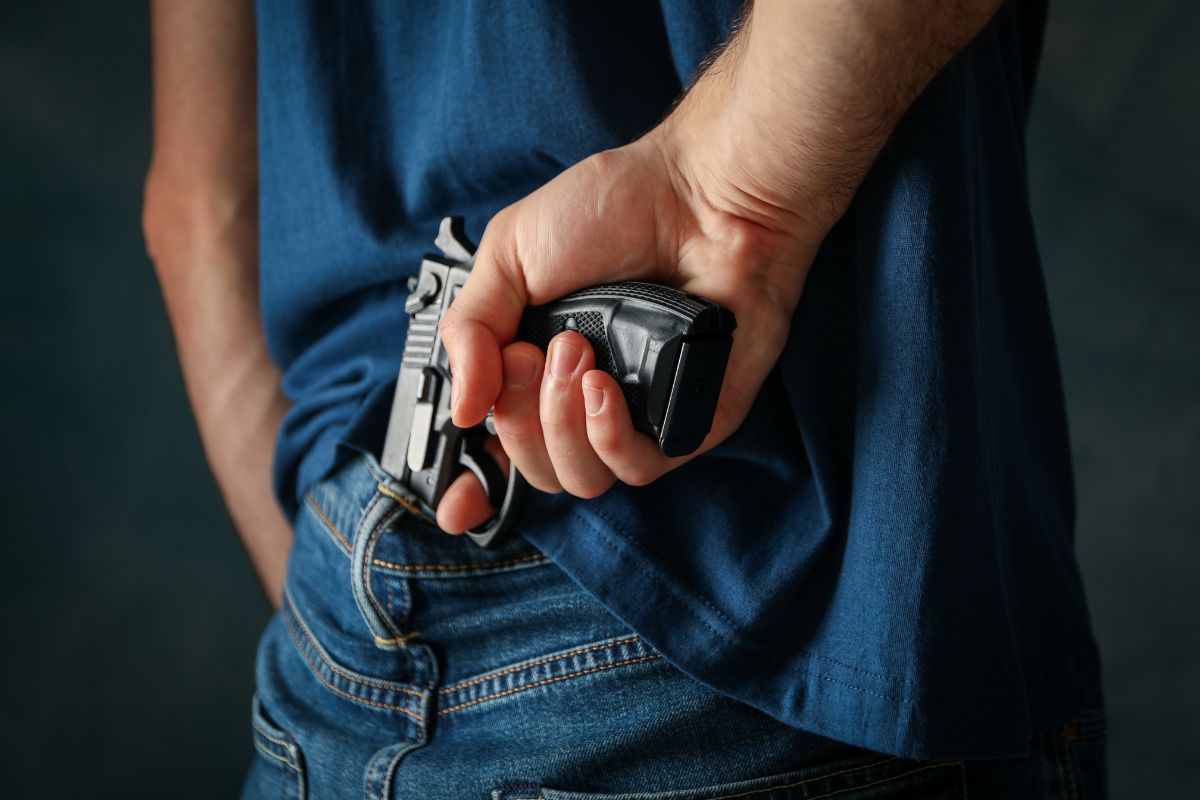What is a Carrying Weapon While Attending Public Meeting Charge?
Carrying weapon while attending public meeting is covered under s. 89 of the Criminal Code in Part II. Part II covers “Firearms and Other Weapons”.
A carrying weapon while attending public meeting charge occurs where an individual carries a weapon, prohibited device or ammunition while the individual is on the way or attending a public meeting, without lawful excuse to do so. Weapons are defined under s. 2 of the Criminal Code (1988): a weapon is anything that is used or intended to be used to cause injury, death, for the purpose of threatening or intimidating another as well as any firearms defined under s. 82 of the Criminal Code (1988).
Carrying weapon while attending public meeting is a summary offence. Summary offences are governed under Part XXVII of the Criminal Code, under the “Summary Conviction” section. Summary convictions have maximum penalties of two years less a day in jail, a $5000 fine, or both.
Examples
Some examples of a carrying weapon while attending public meeting may include the following:
- The accused carried a concealed weapon on public transportation;
- The accused attended a protest with a weapon — which can also raise unlawful assembly considerations in some circumstances;
- The accused carried a weapon, such as a prohibited knife, while in a restaurant; and
- The accused attended a public event, with ammunition and no lawful excuse to do so.
Defences
The defences available to a carrying weapon while attending public meeting charge depend entirely on the facts of your case.
However, some defences to a carrying weapon while attending public meeting charge may include:
- The accused had a lawful excuse to carry a weapon while attending a public meeting;
- The accused was not carrying a prohibited weapon while attending a public meeting;
- The accused was carrying a knife, which does not qualify as a weapon, and did not have the intention to use it as a weapon;
- The accused was wrongfully identified as the person who carried a weapon while attending a public meeting; and
- The accused was not arrested lawfully.
Punishment
A carrying weapon while attending public meeting charge is a summary offence, which means the maximum punishment is as follows:
- Imprisonment for a term of up to but not including 2 years and a $5000 fine.
Punishments for carrying weapon while attending public meeting depend on if the Crown elects to pursue the charge as an indictable offence or summarily. There are no mandatory minimum penalties for this offence. The maximum is two years less a day, and a potential fine of $5000.
A carrying weapon while attending public meeting charge results in a criminal record, and may entail severe consequences for current and future employment opportunities and immigration status.
Overview of the Offence
According to s. 89 of the Criminal Code:
Carrying weapon while attending public meeting
89 (1) Every person commits an offence who, without lawful excuse, carries a weapon, a prohibited device or any ammunition or prohibited ammunition while the person is attending or is on the way to attend a public meeting.
Punishment
(2) Every person who commits an offence under subsection (1) is guilty of an offence punishable on summary conviction.
The Guilty Act (Actus Reus)
The actus reus for a carrying weapon while attending public meeting charge under s. 89 is established by proof, beyond a reasonable doubt, of the following:
Carrying Weapon While Attending Public Meeting 89(1)
- The accused at a specified date and time, carried a weapon, prohibited device, or ammunition as defined under s. 89;
- The accused was on their way to a public meeting; and
- The accused had no lawful excuse for committing the act.
OR
- The accused at a specified date and time, carried a weapon, prohibited device, or ammunition;
- The accused was attending a public meeting; and
- The accused had no lawful excuse for committing the act.
The actus reus refers to the act or the omission itself that constitutes the physical elements of a crime. Thus, the physical aspect of carrying a weapon while attending public meeting would be constituted by any physical act or omission as defined in s. 89. One example of actus reus would be carrying a prohibited knife into a public protest.
The Guilty Mind (Mens Rea)
The mens rea for a carrying weapon while attending public meeting charge under s. 89 includes proving, beyond a reasonable doubt, that:
- The accused knowingly carried a weapon, device or ammunition, whether prohibited or not, while going to a public meeting; and
- The accused had no lawful excuse for doing so.
OR
- The accused knowingly carried a weapon, device or ammunition, whether prohibited or not, while attending a public meeting; and
- The accused had no lawful excuse for doing so.
Mens rea is defined as the knowledge or intention of committing the crime. Thus, knowing that one is carrying a firearm while attending a public event and having no lawful excuse to do so, consists of the mens rea of the charge. As noted in R v Felawka, the Crown must prove that beyond a reasonable doubt, that the accused knew he was carrying an object that he also knew was a weapon.
Defences
How to Beat a Carrying Weapon While Attending Public Meeting Charge
Possible defences will depend on the facts and circumstances of your case. These, as well as the evidence available, will dictate the strength of each available defence. Listed below are some common defences that may be helpful in fighting a carrying weapon while attending public meeting charge.
Factual Innocence
Factual innocence is one possible defence against a carrying weapon while attending public meeting charge. If you can prove, using the facts and the evidence of your case, that you were not engaged in an act of carrying a weapon while attending or on your way to attend a public meeting, or, that the evidence cannot place you as the perpetrator of such an act, then you may be able to defend yourself by stating that you were factually innocent. This can be done for example by proving, beyond a reasonable doubt, that you were not on your way to a public meeting while carrying a weapon.
Lawful Excuse for Carrying a Weapon While Attending a Public Meeting
For this to be a defence against a carrying weapon while attending public meeting charge, you must be able to show that you were legally allowed to carry a weapon while attending a public meeting. To do so, you would have to show proof of your legal capacity to carry a weapon in a public meeting.
Identity
A defence based on the identity of the perpetrator may be a defence to a carrying weapon while attending public meeting charge. For this defence to be raised successfully in court, you would have to prove that you did not commit this act. Alternatively, if you can prove that you were not there at the time the offence was committed, you would raise an alibi defence. This is a defence that states that the accused was wrongfully convicted. Evidence that can be submitted to create a solid identification defence is eyewitness identification, DNA evidence, media, and fingerprints.
Any Applicable Charter Defences
The Charter sets out your rights and freedoms before and after your arrest. If the police fail to abide by these rights deliberately or inadvertently, it could aid in your defence. If any of your Charter rights have been violated before or after your arrest, you may be able to have some or all of the evidence that the Crown is relying on to secure a conviction excluded under s. 24(2) of the Charter.
Punishments
The Criminal Code provides for a possible term of imprisonment of two years less a day imprisonment. A fine is also possible under this section, either in conjunction with imprisonment or alone. Individuals who are charged with this act may also have their weapons seized by law enforcement.
Those found guilty of carrying a weapon while attending a public meeting, are also eligible for a release by peace officer on undertaking through s. 498, 499 and 501 of the Criminal Code, for an appearance notice by peace officer under s. 497, and/or for a summon by judge or justice, under s. 508(1), 512(1) or 788 of the Criminal Code. Therefore, when charged, the individual may be given an appearance notice without arrest or summons, and when arrested, the individual may be released by the arresting officer on an undertaking.
The accused will not be required to attend a police station to have their fingerprints taken under the Identification of Criminals Act.








